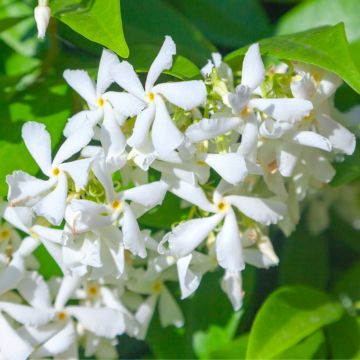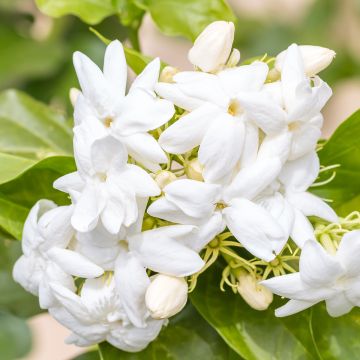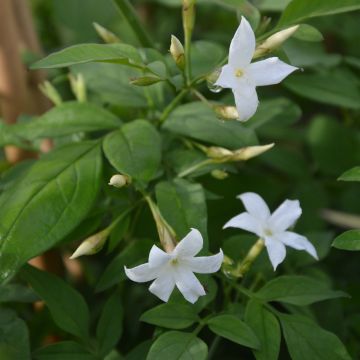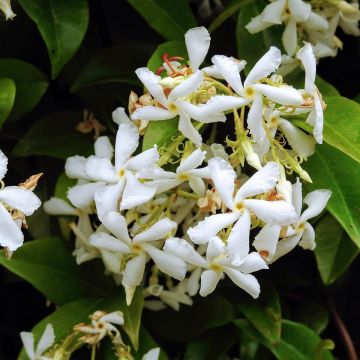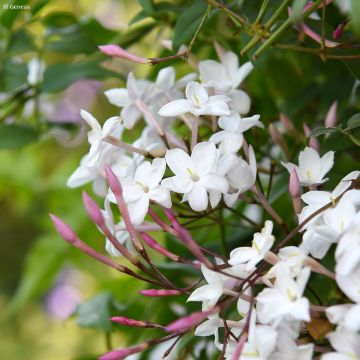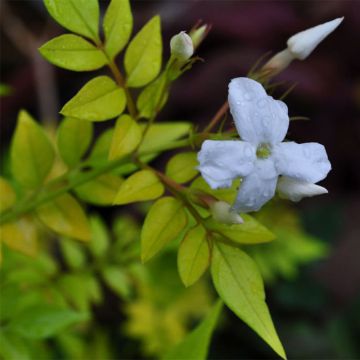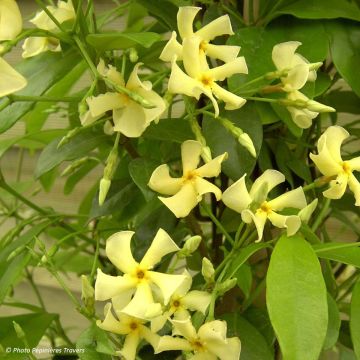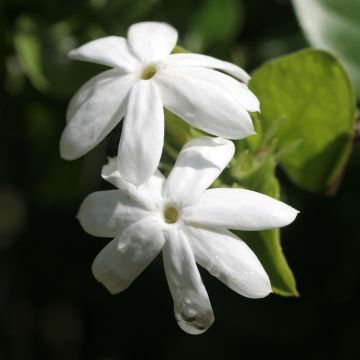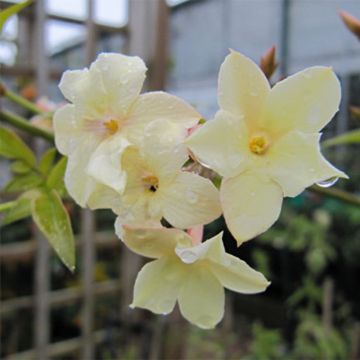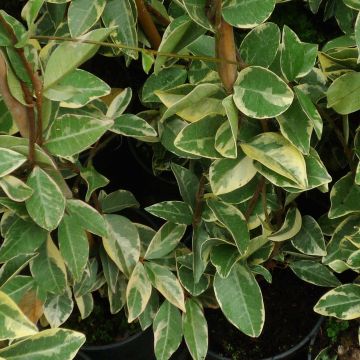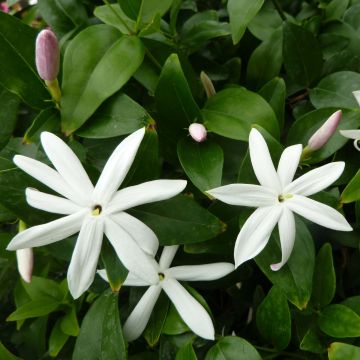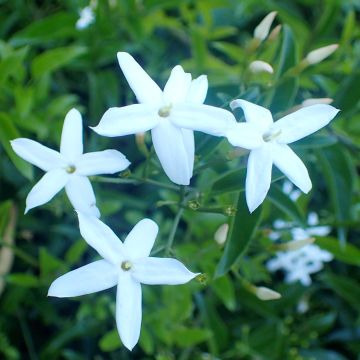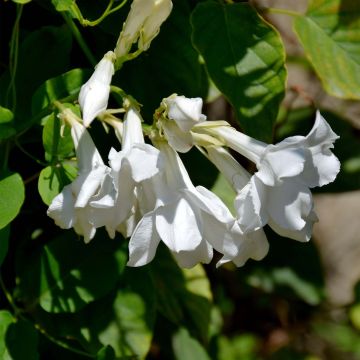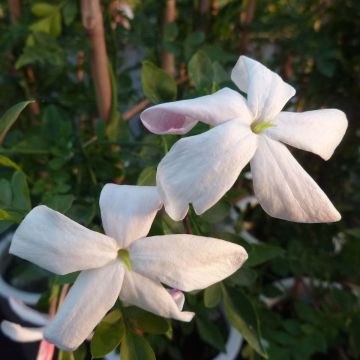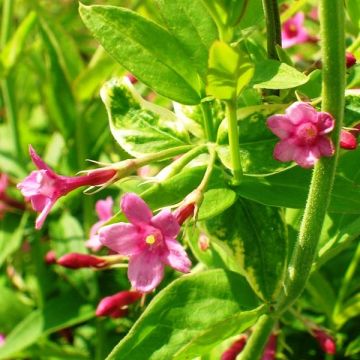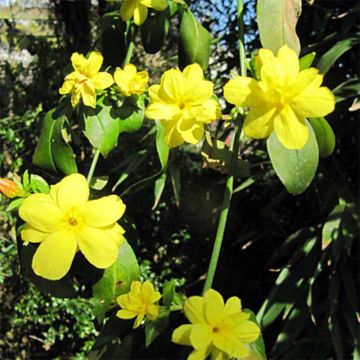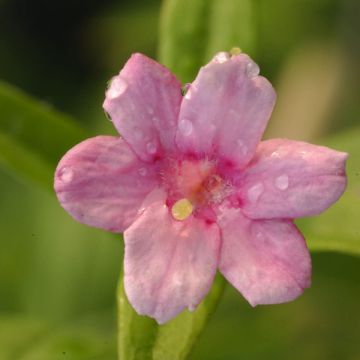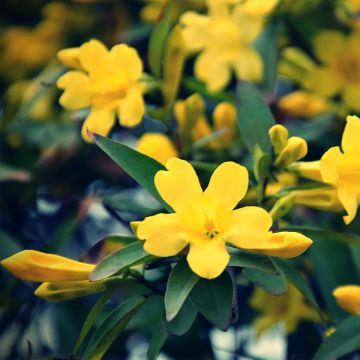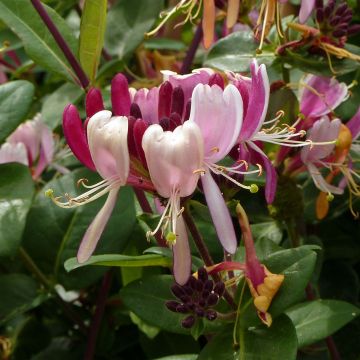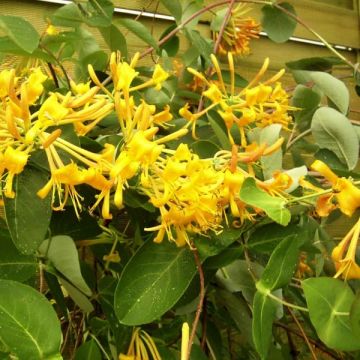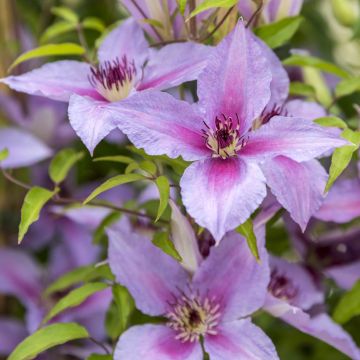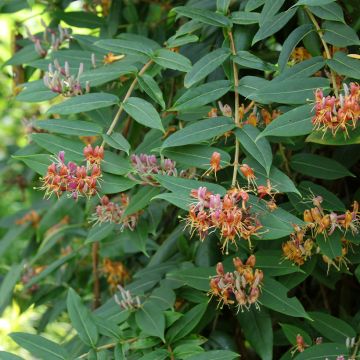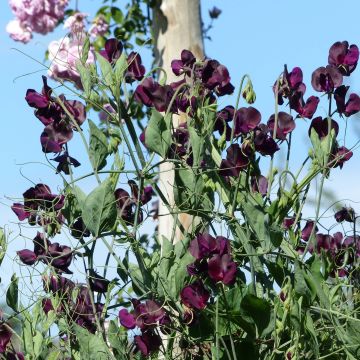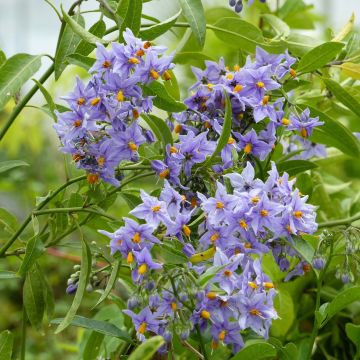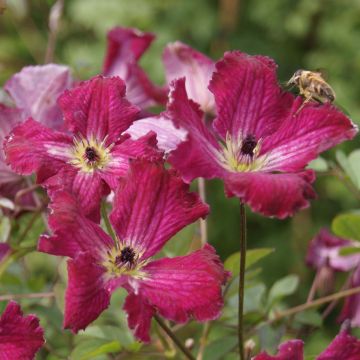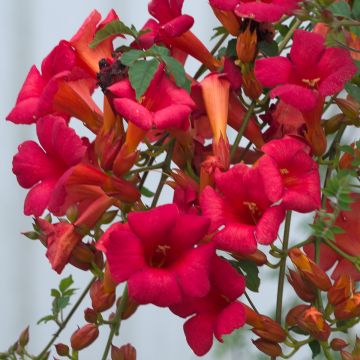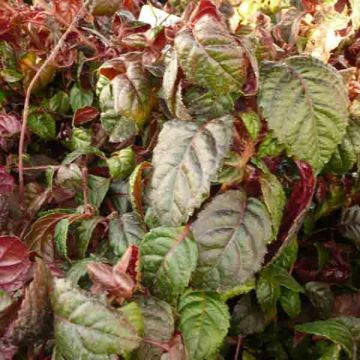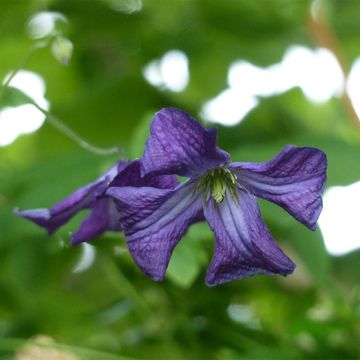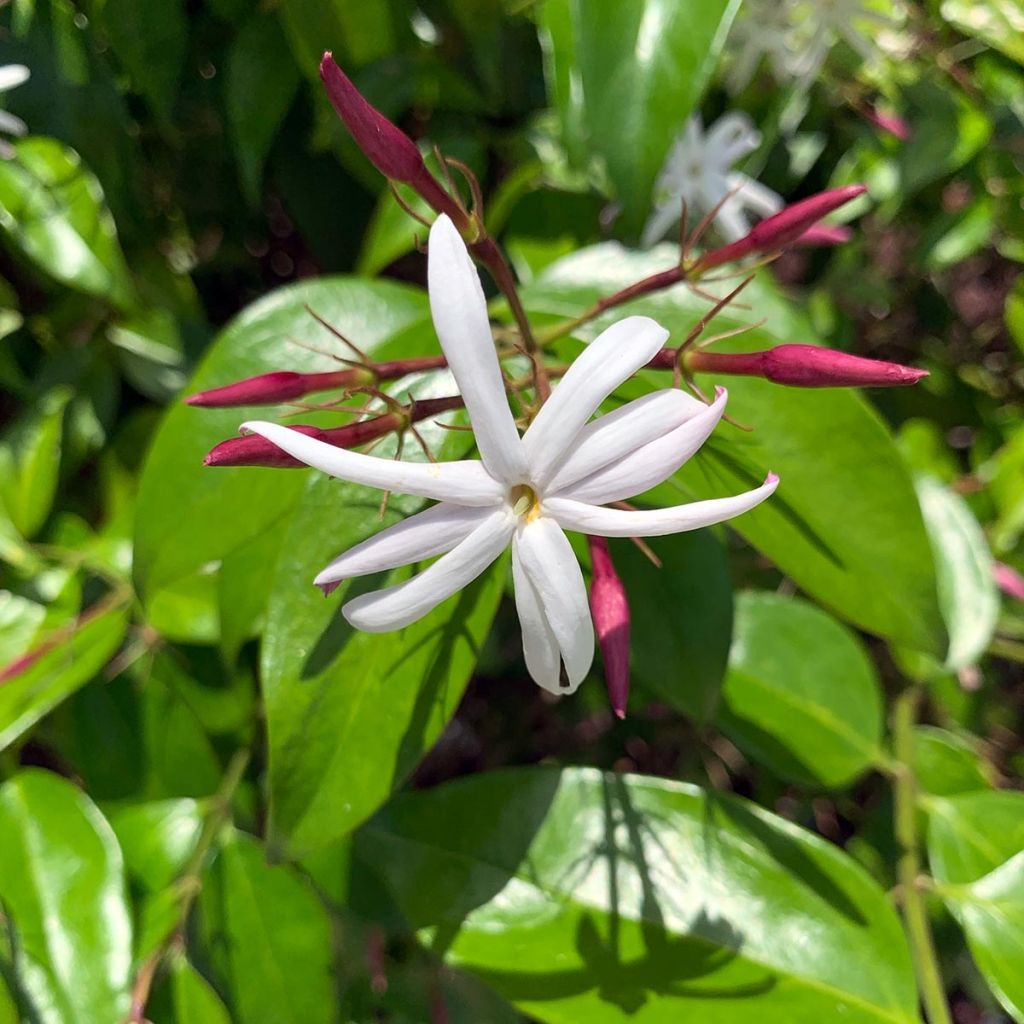

Jasminum nitidum - Jasmin
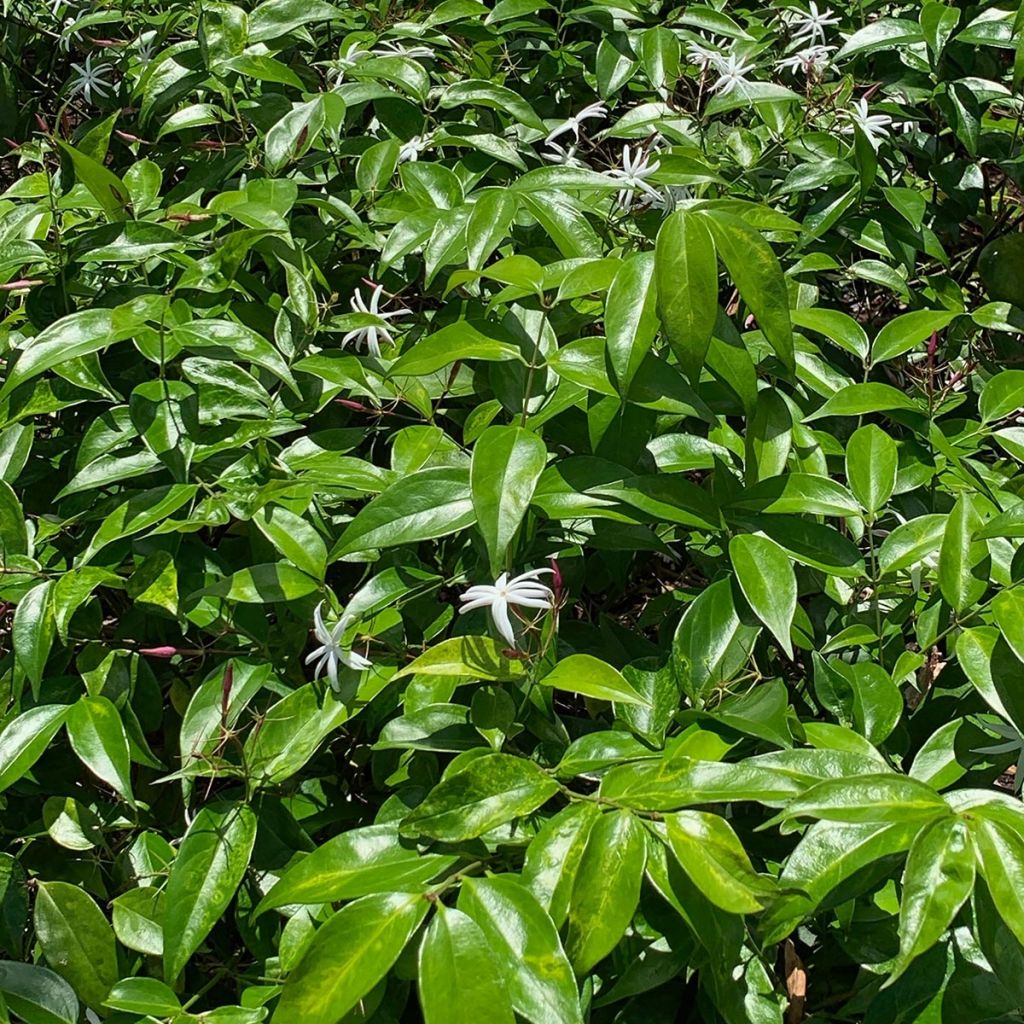

Jasminum nitidum - Jasmin
Jasminum laurifolium var. nitidum - Angel-wing Jasmine
Jasminum laurifolium var. nitidum
Angelwing Jasmine, Shining Jasmine
Why not try an alternative variety in stock?
View all →This plant carries a 6 months recovery warranty
More information
We guarantee the quality of our plants for a full growing cycle, and will replace at our expense any plant that fails to recover under normal climatic and planting conditions.
From €5.90 for pickup delivery and €6.90 for home delivery
Express home delivery from €8.90.
Does this plant fit my garden?
Set up your Plantfit profile →
Description
The Jasminum laurifolium var. nitidum is a rare jasmine in cultivation, more suited to container gardening than being planted in the ground due to its tender nature. It is a more or less climbing plant, with a prolonged and delicate flowering period, both in terms of the refined shape of its large flowers and their subtle fragrance. They open in the evening and at night, from delicate violet buds, against a backdrop of beautiful dark green foliage. Place it in a lovely pot, and it will perfume an entire area of the garden, balcony, or terrace on summer evenings.
Jasminum nitidum belongs to the Oleaceae family. This botanical species is sometimes called 'Angelwing jasmine' by English speakers, due to the very distinctive shape of its flowers, royal jasmine, or even shining jasmine. It is native to the Himalayas and Southeast Asia, where it is found in forests, thickets, scrub vegetation, and garrigues. Not very hardy, this jasmine perishes below -3°C (26.6°F). In its natural environment, it is a vigorous plant that can reach 6 meters (20 feet) in length. In tropical gardens, it is often pruned into a bush.
This sarmentous bush will remain relatively small in a pot, not exceeding 2.50 to 3 meters (8 to 10 feet) in height and can be maintained as a bush through regular pruning. Its growth rate is moderate. The flowering period is long, lasting at least three months, from June to September. The plant produces numerous clusters of flowers, approximately 5 cm (2in) in diameter. Each flower is composed of a tube that opens into 9 very narrow lobes, giving them the appearance of a spider. Their fragrance is both powerful and subtle, and they open in the evening and at night. The vegetation of this jasmine consists of long, flexible, and supple stems that weave their way through the branches of neighboring plants. They are not climbing and do not have any attachment system. The foliage is more or less evergreen, composed of leathery, elliptical leaves with undulate margins, 5 cm (2in) long, arranged oppositely on the stems. They are shiny dark green. The stems become woody and light brown with age, devoid of leaves. The fruit is a round, black berry, 6 mm (0in) in diameter when ripe.
In all regions, place this royal jasmine in a container on a terrace, so that it can be stored indoors during winter, and to fully enjoy its wonderful fragrance. However, avoid placing it near a bedroom with an open window; some claim that its fragrance disrupts sleep and can cause headaches. It can, for example, be paired with another climbing plant with a different or simultaneous flowering period, such as the Clematis 'Dancing Queen', the Sollya heterophylla, or even the Passiflora 'Essenza', for example.
Report an error about the product description
Jasminum laurifolium var. nitidum - Angel-wing Jasmine in pictures
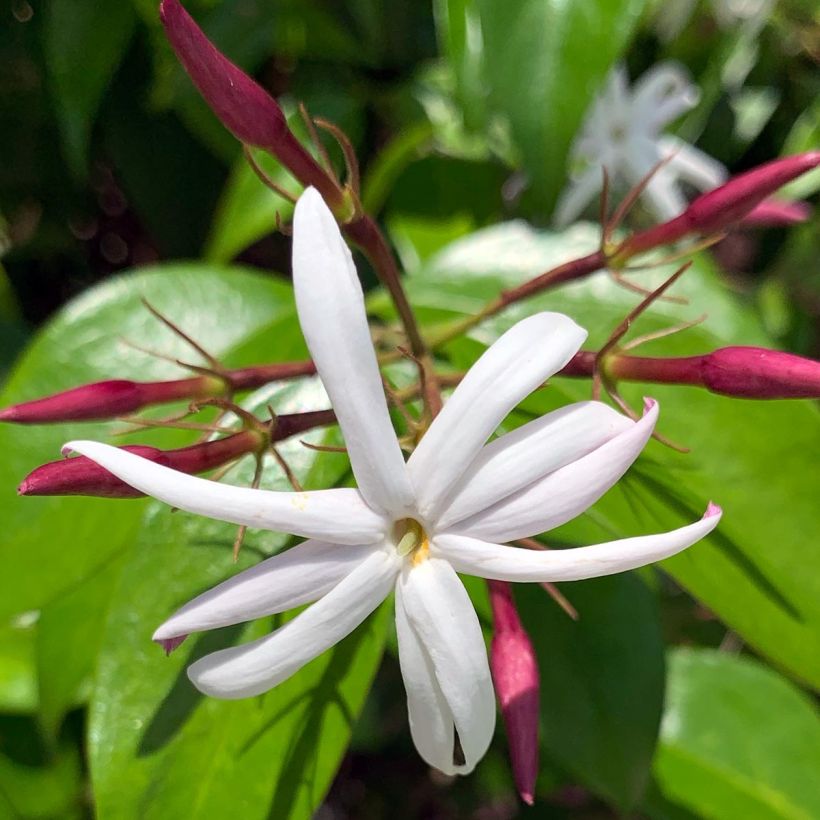

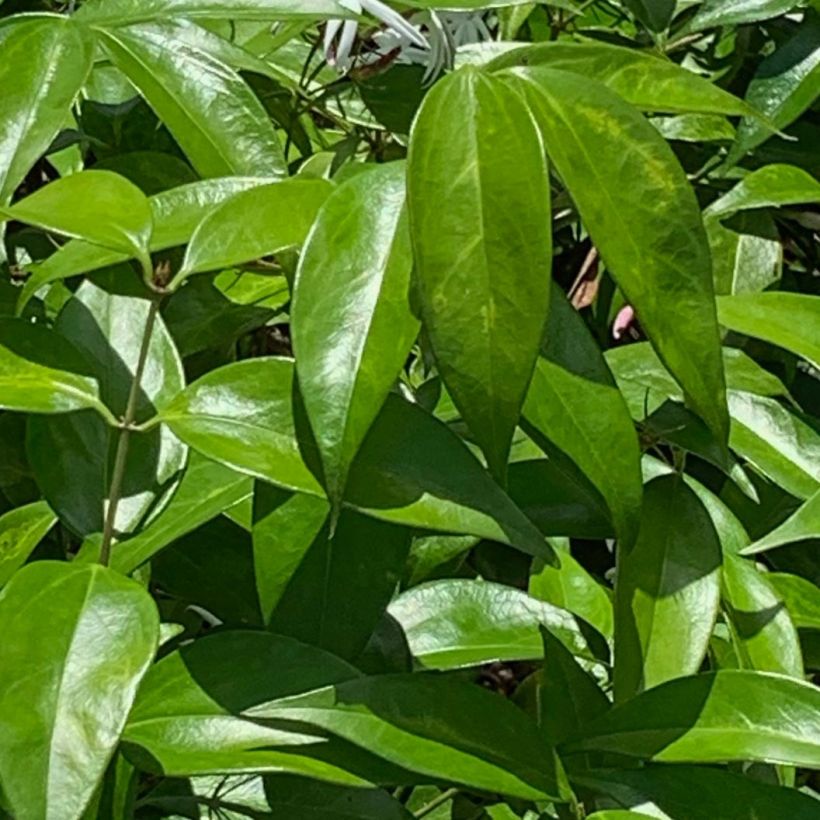

Plant habit
Flowering
Foliage
Botanical data
Jasminum
laurifolium var. nitidum
Oleaceae
Angelwing Jasmine, Shining Jasmine
Oceania
Other Jasmine
Planting and care
In our milder regions (orange tree zone), Jasminum nitidum can potentially be planted in open ground, preferably in spring, with winter protection as soon as frost is announced: it perishes below -3°C (26.6°F). It can be planted in pots all year round, in all our regions. Plant it in good horticultural compost, kept moist. It will thrive in a sunny position, or even in partial shade in hot climates. Pruning of the oldest stems (brown) is necessary at the end of winter, when vegetation starts.
For pot cultivation: choose a container of 50 cm (20in), in good, rich, moist and light compost, specifically for Mediterranean plants. From early spring until mid-September, enrich with liquid fertilizer every 15 days, always on moist compost. In summer, it needs abundant watering, but in winter let the compost dry out slightly between waterings. Jasmine is very vigorous even in pots and may become sparse at the base. In this case, prune the old branches to leave only 3 young shoots. In winter, place it in a conservatory or a temperate greenhouse, around 16°C (60.8°F), with plenty of light. Regularly spray the foliage with non-calcareous water, this will prevent attacks from red spiders.
Planting period
Intended location
Care
This item has not been reviewed yet - be the first to leave a review about it.
Summer flowering climbers
Haven't found what you were looking for?
Hardiness is the lowest winter temperature a plant can endure without suffering serious damage or even dying. However, hardiness is affected by location (a sheltered area, such as a patio), protection (winter cover) and soil type (hardiness is improved by well-drained soil).

Photo Sharing Terms & Conditions
In order to encourage gardeners to interact and share their experiences, Promesse de fleurs offers various media enabling content to be uploaded onto its Site - in particular via the ‘Photo sharing’ module.
The User agrees to refrain from:
- Posting any content that is illegal, prejudicial, insulting, racist, inciteful to hatred, revisionist, contrary to public decency, that infringes on privacy or on the privacy rights of third parties, in particular the publicity rights of persons and goods, intellectual property rights, or the right to privacy.
- Submitting content on behalf of a third party;
- Impersonate the identity of a third party and/or publish any personal information about a third party;
In general, the User undertakes to refrain from any unethical behaviour.
All Content (in particular text, comments, files, images, photos, videos, creative works, etc.), which may be subject to property or intellectual property rights, image or other private rights, shall remain the property of the User, subject to the limited rights granted by the terms of the licence granted by Promesse de fleurs as stated below. Users are at liberty to publish or not to publish such Content on the Site, notably via the ‘Photo Sharing’ facility, and accept that this Content shall be made public and freely accessible, notably on the Internet.
Users further acknowledge, undertake to have ,and guarantee that they hold all necessary rights and permissions to publish such material on the Site, in particular with regard to the legislation in force pertaining to any privacy, property, intellectual property, image, or contractual rights, or rights of any other nature. By publishing such Content on the Site, Users acknowledge accepting full liability as publishers of the Content within the meaning of the law, and grant Promesse de fleurs, free of charge, an inclusive, worldwide licence for the said Content for the entire duration of its publication, including all reproduction, representation, up/downloading, displaying, performing, transmission, and storage rights.
Users also grant permission for their name to be linked to the Content and accept that this link may not always be made available.
By engaging in posting material, Users consent to their Content becoming automatically accessible on the Internet, in particular on other sites and/or blogs and/or web pages of the Promesse de fleurs site, including in particular social pages and the Promesse de fleurs catalogue.
Users may secure the removal of entrusted content free of charge by issuing a simple request via our contact form.
The flowering period indicated on our website applies to countries and regions located in USDA zone 8 (France, the United Kingdom, Ireland, the Netherlands, etc.)
It will vary according to where you live:
- In zones 9 to 10 (Italy, Spain, Greece, etc.), flowering will occur about 2 to 4 weeks earlier.
- In zones 6 to 7 (Germany, Poland, Slovenia, and lower mountainous regions), flowering will be delayed by 2 to 3 weeks.
- In zone 5 (Central Europe, Scandinavia), blooming will be delayed by 3 to 5 weeks.
In temperate climates, pruning of spring-flowering shrubs (forsythia, spireas, etc.) should be done just after flowering.
Pruning of summer-flowering shrubs (Indian Lilac, Perovskia, etc.) can be done in winter or spring.
In cold regions as well as with frost-sensitive plants, avoid pruning too early when severe frosts may still occur.
The planting period indicated on our website applies to countries and regions located in USDA zone 8 (France, United Kingdom, Ireland, Netherlands).
It will vary according to where you live:
- In Mediterranean zones (Marseille, Madrid, Milan, etc.), autumn and winter are the best planting periods.
- In continental zones (Strasbourg, Munich, Vienna, etc.), delay planting by 2 to 3 weeks in spring and bring it forward by 2 to 4 weeks in autumn.
- In mountainous regions (the Alps, Pyrenees, Carpathians, etc.), it is best to plant in late spring (May-June) or late summer (August-September).
The harvesting period indicated on our website applies to countries and regions in USDA zone 8 (France, England, Ireland, the Netherlands).
In colder areas (Scandinavia, Poland, Austria...) fruit and vegetable harvests are likely to be delayed by 3-4 weeks.
In warmer areas (Italy, Spain, Greece, etc.), harvesting will probably take place earlier, depending on weather conditions.
The sowing periods indicated on our website apply to countries and regions within USDA Zone 8 (France, UK, Ireland, Netherlands).
In colder areas (Scandinavia, Poland, Austria...), delay any outdoor sowing by 3-4 weeks, or sow under glass.
In warmer climes (Italy, Spain, Greece, etc.), bring outdoor sowing forward by a few weeks.

































